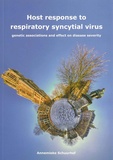Host response to respiratory syncytial virus
Genetic associations and effect on disease severity

Schuurhof, Annemieke
- Promoter:
- Prof.dr. J.L.L. (Jan) Kimpen
- Co-promoter:
- Dr. L.J. (Louis) Bont & dr. R. Janssen
- Research group:
- Bont
- Date:
- March 6, 2012
- Time:
- 16:15 h
Summary
Respiratory syncytial virus (RSV) is the most frequent cause of severe respiratory tract infections in young children. Almost all children become infected with RSV during the first two years of life, and 1-3% needs hospitalization. Genetic determinants are believed to play a role in the risk of developing RSV infection in healthy infants. In this thesis, the functional role of the previously reported associated gene variants during RSV infection is studied. We aimed to determine the in vivo role of interleukin-10 in RSV pathogenesis and recurrent wheeze in a new cohort of 235 infants hospitalized for RSV bronchiolitis. IL-10 levels in nasopharyngeal aspirates (NPAs) at the time of hospitalization turned out to be higher in infants that later developed physician diagnosed PBW as compared to infants without PBW in the first year after RSV infection. We further studied the local immune response in NPAs during RSV infection. TIMP metallopeptidase inhibitor (TIMP)-1 was higher in the NPAs of hospitalized infants with severe RSV disease compared to the NPAs of infants at home with mild disease. Similar results were found for matrix metalloproteinase (MMP)-3. MMP-3 as a marker of disease severity was confirmed in a larger cohort and MMP3 gene polymorphism rs522616 was associated with severe RSV infection. Therefore, extracellular matrix proteinases play an important role in the pathogenesis of RSV bronchiolitis. Additionally, we reported transcription profiles in the lungs of RSV-infectedmice examined by microarray analysis to elucidate which mechanisms underliethe effect of vaccine-induced immunity on the course of RSVinfection. Three models wereused: RSV reinfection as a model for natural immunity, RSV challengeafter formalin-inactivated RSV vaccination as a model for vaccine-enhanceddisease, and RSV challenge following vaccination with recombinantRSV lacking the G gene (DG-RSV) as a model for vaccine-inducedimmunity. On the first days after challenge, all mice showed a strong innate immune response. On day 5 after RSVreinfection or after challenge following DG-RSV vaccination,the innate immune response was waning. In contrast, in micewith vaccine-enhanced disease, the innate immune response 5days after RSV challenge was still present even though viralreplication was diminished. These findings support a hypothesisthat vaccine-enhanced disease is mediated by prolonged innateimmune responses and Th2 polarization in the absence of viralreplication. Moreover, we described transcription profiles in the blood and bronchial lymph nodes of RSV-infectedmice to improve our understanding of systemic host responses to RSV. 53 interferon-associated and innate immunity genes were identified that give correlated responses in all three murine tissues. We identified blood gene signatures that are indicative of acute infection, secondary immune response, and vaccine-enhanced disease, respectively. These results indicate that it may be possible to distinguish protective and unfavorable patient lung responses via blood diagnostics. Finally, we discussed on the host response to RSV infection. To conclude, host genetic studies offer a complex but robust method to improve our understanding of disease pathogenesis and develop new targets for intervention for one of the most common diseases during early childhood.